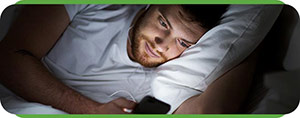The Impact of Bedtime Technology Use on Sleep Quality
Using electronic devices in the bedroom can significantly disrupt sleep patterns. The exposure to blue light and the disruption of circadian rhythms can make it challenging for individuals to transition from a state of alertness to relaxation. Sleep services are available at the Koala® Center For Sleep & TMJ Disorders. For more information, please contact us or book an appointment online now! We have convenient locations across the USA in Bloomington IL, Peoria/Dunlap IL, El Paso TX, and Wausau WI.


Table of Contents:
How does screen time before bed affect sleep quality?
What is blue light, and how does it impact sleep?
Can using electronic devices in the bedroom disrupt sleep patterns?
What are some strategies for reducing the negative impact of technology on sleep?
Screen time before bed is increasingly recognized by sleep experts as a significant cause of sleep disruption. The blue light emitted during screen time is a type of light spectrum that is particularly active in influencing an individual’s sleep cycle.
This exposure can suppress the production of melatonin, the hormone that aids in falling asleep, making it difficult for individuals to fall asleep and affecting the quality of sleep as a result.
Additionally, the content consumed during screen time can overstimulate the brain, lead to feelings of stress or anxiety, and encourage individuals to stay awake longer, as the brain remains busy processing information instead of relaxing and preparing for rest.
This can make the transition to sleep more challenging and result in various adverse impacts on sleep quality, stemming from too much screen time in the evening and exposure too close to bedtime.
Blue light is a wavelength of light emitted by screens, including electronic devices, fluorescent lights, and LED lights. It is capable of influencing sleep cycles, alertness, and hormone production and is a significant portion of the visible light spectrum.
Blue light can trick the brain into thinking it is daytime, which inhibits the production of melatonin, a natural hormone essential for preparing the body for rest. This delay in melatonin production can disrupt an individual’s circadian rhythm, the 24-hour cycle that signals the body to carry out essential functions, including achieving an appropriate amount of sleep.
Exposure to blue light after sunset can suppress the body’s release of melatonin, leading to difficulties falling asleep and promoting feelings of alertness rather than tiredness.
Using electronic devices in the bedroom can significantly disrupt sleep patterns. The exposure to blue light and the disruption of circadian rhythms can make it challenging for individuals to transition from a state of alertness to relaxation.
Depending on the content accessed through these devices, users may experience mood disruptions, including feelings of anxiety, stress, or depression. Moreover, engagement with algorithm-based content, which is designed to keep users hooked, can push bedtime later and later, further disrupting the natural sleep and wakefulness cycle.
This disruption can have adverse effects on all aspects of an individual’s physical and mental health and wellness.
There are several effective strategies for reducing the negative impact of technology on sleep. One of the best courses of action is to limit screen time throughout the evening and avoid screen exposure directly before bedtime.
Individuals concerned about sleep hygiene or experiencing sleep-related health issues can consult with experts at the Koala® Center For Sleep & TMJ Disorders for customized guidance and treatment plans.
Additionally, turning off screens at least an hour before bed is an excellent practice. Individuals can start by reducing screen time by 15 or 30 minutes before bed and gradually increasing this time. Establishing a firm bedtime routine, both in terms of behavior and timing, can help promote a better transition from waking to sleep.
This can involve the elimination of electronics and switching over to healthier bedtime activities, such as reading a book. Using dim lighting in the bedroom at night and ensuring a comfortable sleeping environment with cool temperatures and comfortable bedding can also promote more effective sleep. For those having difficulty making these changes, using devices in dark mode or night mode at least changes the screen from blue hues to red hues, which minimizes disruptions to some extent.
Sleep services are available at the Koala® Center For Sleep & TMJ Disorders. Visit us online now to learn more about our services and for directions to our locations! We also encourage everyone to visit us online to meet our team and to sign up for our special offers!

Additional Services You May Need
▸ KoalaKIDZzz®
▸ Sleep Apnea
▸ Snoring
▸ TMJ Disorder
▸ Fatigue
▸ Sleep Disorders
▸ Weight Loss
▸ CPAP Alternative
▸ Oral Appliances




